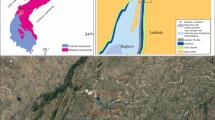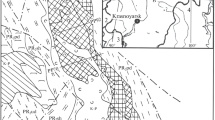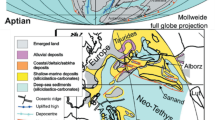Abstract
Celestite mineralization in the Likak deposit is hosted by Early to Middle Miocene Gachsaran evaporitic formation. The celestite-bearing layers are composed of medium- to coarse-grained celestite crystals with different morphologies in a carbonate groundmass. The presence of carbonate and gypsum inclusions within celestite crystals as well as the pseudomorphic habits of some crystals suggests that celestite replaced preexisting carbonate and gypsum. The lithofacies features and faunal assemblage of the host rocks indicate subtidal–supratidal environments of deposition for country rocks. Strontium isotope analyses indicate that Sr originated from Middle Miocene seawater. Sulfur isotopic ratios indicate higher δ34S values in analyzed samples than those of Middle Miocene seawater. These higher values were probably resulted by bacterial reduction of sulfate. Based on petrographic evidences and Sr-isotope ages, it is revealed that mineralization occurred as a late-diagenetic process during deposition of Gachsaran Formation. Taking into account the available data, it can be suggested that precursors of the mineralizing fluids were probably produced by evaporation of seawater in a coastal sabkha setting. As these brines entered into underlying sediments, they leached considerable amounts of Sr from host sediments. Once these Sr-enriched fluids discharged back up into overlying beds containing gypsum and carbonate materials, celestite precipitation took place by replacement of the preexisting minerals as well as by mixing of the mineralizing fluids with sulfate-enriched brines entrapped within the beds.








Similar content being viewed by others
References
Abdollahie Fard I, Sepehr M, Sherkati S (2011) Neogene salt in SW Iran and its interaction with Zagros folding. Geol Mag 148:854–867
Agard P, Omrani J, Jolivet L, Whitchurch H, Vrielynck B, Spakman W, Monie P, Meyer B, Wortel R (2011) Zagros orogeny: a subduction-dominated process. Geol Mag 148:692–725
Aghanabati A (2004) Geology of Iran. Geological Survey of Iran Publications, Farsi
Alavi M (2004) Regional stratigraphy of the Zagros fold-thrust belt of Iran and its proforeland evolution. Am J Sci 304:1–20
Allen MB, Budd GE, Leat PT, Whitham AG (eds) (2011) Geodynamic evolution of the Zagros. Geol Mag 148:687–1019
Amini Movahed M, Moghaddasi SJ, Babazadeh, SA (2009) A study of mineralogy and texture of Mazrae celestite ore deposit, Qom, Iran. National conference on investigating new techniques of earth sciences, Farsi
Bahroudi A, Koyi HA (2004) Tectono-sedimentary framework of the Gachsaran formation in the Zagros foreland basin. Mar Petrol Geol 21:1295–1310
Bazargani-Guilani K, Nekouvaght Tak MA (2008) Celestite ore deposit and occurrences of the Qom Formation, Oligo-Miocene, Central Iran. 2nd IASME/WSEAS international conference on geology and seismology, Cambridge, UK, pp 48–54
Bazargani-Guilani K, Rabbani MS (2005) Deposition of stratiform celestite of Aftar region, west of Semnan, Iran. Geosci Iran 12:30–41 (in Farsi)
Butler GP (1969) Modern evaporite deposits and geochemistry of coexisting brines, the sabkha, Trucial Coast, Arabian Gulf. J Sed Petrol 39:70–89
Canfield DE (2001) Isotope fractionation by natural populations of sulphate-reducing bacteria. Geochim Cosmochim Acta 65:1117–1124
Carlson EH (1987) Celestite replacements of evaporites in the Salina Group. Sed Geol 54:93–112
de Brodtkorb MK (1989) Celestite, worldwide classical ore fields. In: de Brodtkorb MK (ed) Nonmetalliferous stratabound ore fields. Van Nostrand, New York, pp 17–39
de Brodtkorb MK, Ramos V, Barbieri M, Ametrano S (1982) The evaporitic celestite-barite deposits of Neuquen, Argentina. Miner Deposita 17:423–436
Dill HG (2010) The “chessboard” classification scheme of mineral deposits: mineralogy and geology from aluminum to zirconium. Earth Sci Rev 100:1–420
Dill HG, Henjes-Kunst F, Berner Z, Stüben D (2009) Miocene diagenetic and epigenetic strontium mineralization in calcareous series from Cyprus and the Arabian Gulf: metallogenic perspective on sub- and suprasalt redox-controlled base metal deposits. J Asian Earth Sci 34:557–576
Ehrenberg SN, Pickard NAH, Laursen GV, Monibi S, Mossadegh ZK, Svana TA, Aqrawi AAM, McArthur JM, Thirlwall MF (2007) Strontium isotope stratigraphy of the Asmari formation (Oligocene–Lower Miocene), SW Iran. J Petrol Geol 30:107–128
Ehya F (1997) Geology, geochemistry, and the origin of celestite-bearing horizon of Gachsaran formation, Likak-Behbahan, Kohgiloye-va-Boyrahmad Province, Unpublished Msc Thesis, Shiraz University, Shiraz, Iran, Farsi
Ehya, F (2002) Geology and the origin of Mokhdan celestite occurrence, Busher Province, Iran. 20th symposium on geosciences, geological survey of Iran, Farsi
Farahani Fard N, Rasa I (2009) Mineralogy and geochemistry of celestine mining material, Arvaneh Mine in North West Semnan. National conference on investigating new techniques of earth sciences, Farsi
Ghasemi A, Talbot CJ (2006) A new tectonic scenario for the Sanandaj-Sirjan zone (Iran). J Asian Earth Sci 26:683–693
Gill WD, Ala MA (1972) Sedimentology of Gachsaran formation (lower Fars series), Southwest Iran. Am Assoc Pet Geol Bull 56:1965–1974
González-Sánchez F, Camprubí A, González-Partida E, Puente-Solís R, Canet C, Centeno-García E, Atudorei V (2009) Regional stratigraphy and distribution of epigenetic stratabound celestine, fluorite, barite and Pb–Zn deposits in the MVT province of northeastern Mexico. Miner Deposita 44:343–361
Hanor JS (2000) Barite-celestite geochemistry and environments of formation. In: Alpers CN, Jambor JL, Nordstorm DK (eds) Sulfate minerals: crystallography, geochemistry, and environmental significance. Rev Mineral Geochem 40:193–263
Hanor JS (2004) A model for the origin of large carbonate- and evaporite-hosted celestine deposits. J Sediment Res 74:168–175
Howarth RJ, McArthur JM (1997) Statistics for strontium isotope stratigraphy with a look-up table version. J Geol 105:441–456
James GA, Wynd JG (1965) Stratigraphical nomenclature of Iranian oil consortium agreement area. Am Assoc Pet Geol Bull 49:2182–2245
Kashfi MS (1980) Stratigraphy and environmental sedimentology of lower Fars Group (Miocene), South-Southwest Iran. Am Assoc Pet Geol 64:2095–2107
Kendall CGStC, Skipwith PAd’E (1969) Holocene shallow-water carbonate and evaporite sediments of Khor al Bazam, Abu Dhabi, Southwest Persian Gulf. Am Assoc Pet Geol Bull 53:841–869
Kesler SE, Jones LM (1981) Sulphur and strontium isotopic geochemistry of celestite, barite and gypsum from Mesozoic Basins of northeastern Mexico. Chem Geol 31:211–240
Kinsman DJJ (1966) Gypsum and anhydrite of recent age, Persian Gulf. In: 2nd symposium on salt, Cleveland, Northern Ohio Geol Soc vol 1, pp 302–326
Klein C, Hurlbut CS Jr (1985) Manual of mineralogy after Dana JD (ed) 21st edn (revised) Wiley, New York
Lu FH, Meyers WJ, Schoonen MA (2001) S and O (SO4) isotopes, simultaneous modeling, and environmental significance of the Nijar Messinian gypsum, Spain. Geochim Cosmochim Acta 65:3081–3092
Machel HG (1993) Anhydrite nodules formed during deep burial. J Sed Petrol 63:659–662
Machel HG, Burton EA (1991) Burial diagenetic sabkha-like gypsum and anhydrite nodules. J Sed Petrol 61:394–405
Machel HG, Krouse HR, Sassen R (1995) Products and distinguishing criteria of bacterial and thermochemical sulfate reduction. Appl Geochem 10:373–389
Macleod JH, Akbari Y (1970) Behbahan quadrangle map 1:100000. Iranian Oil Operation Companies
MacMillan JP, Park JW, Gerstenberg R, Wagner H, Kohler K, Wallbrecht P (1994) Strontium compounds and chemicals, 5th edn. Ullmańs encyclopedia of industrial chemistry, vol A25, pp 321–327. VCH Verlagsgesellschaft m.b.H., Weinheim, Germany
Moore F, Jami M (1997) Syngenetic strontium ore deposition at the base of Asmari Formation, Bangestsn anticline, Behbahan, Iran. J Sci I R Iran 8:178–188
Motiei H (1993) Stratigraphy of Zagros. Geological Survey of Iran Publications, Farsi
Müller G (1962) Zur Geochemie des Strontiums in Ozeanen Evaporiten unter besonderer Berücksichtigung der sedimentären Coelestin-Lagerstätte von Hemmelte-Westerfeld (Südoldenburg). Beiheft des geologischen Jahrbuchs 35:1–90
Müller G, Puchelt H (1961) Die Bildung von Cölestin (SrSO4) aus Meerwasser. Naturwissenschaften 48:301–302
Nabian A, Sadeddin N, Mehmannavazan K, Salehinia N (1986) Geological investigation and semi-detailed exploration of Kuh Talhe celestite deposit. Geological Survey of Iran, Farsi
Parsa HR (2000) Celestite prospecting project in Ilam, Dehloran, Eavan and Mehran cities. Ministry of Industry and Mines. Internal Report, Farsi
Paytan A, Kastner M, Campbell D, Thiemens MH (1998) Sulfur isotopic composition of Cenozoic seawater sulfate. Science 282:1459–1462
Pierre C (1985) Isotopic evidence for the dynamic redox cycle of dissolved sulphur compounds between free and interstitial solutions in marine salt pans. Chem Geol 53:191–196
Sabzehei M (1990) Celestite prospecting in Bangestan anticline. Ministry of mines and metals. Internal Report, Farsi
Scholle PA, Stemmerik L, Harpoth O (1990) Origin of major karst-associated celestite mineralization in Karstrygen, central East Greenland. J Sed Petrol 60:397–410
Seal RR, Alpers CN, Rye RO (2000) Stable isotope systematic of sulfate minerals. Rev Mineral 40:541–602
Setudehnia A (1977) The Mesozoic-Tertiary sequence in Southwest Iran and adjacent areas. National Iranian Oil Company, Tehran Report no. 1248
Shearman DJ (1966) Origin of marine evaporites by diagenesis. Trans Inst Min Metal 77:208–215
Sherkati S, Letouzey J (2004) Variation of structural style and basin evolution in the central Zagros (Izeh zone and Dezful Embayment), Iran. Mar Petrol Geol 21:535–554
Sherkati S, Molinaro M, de Lamotte DF, Letouzey J (2005) Detachment folding in the Central and Eastern Zagros fold-belt (Iran): salt mobility, multiple detachments and late basement control. J Struct Geol 27:1680–1696
Stöcklin J (1968) Structural history and tectonics of Iran: a review. Am Assoc Pet Geol Bull 52:1229–1258
Taberner C, Marshall JD, Hendry JP, Pierre C, Thirlwal MF (2002) Celestite formation, bacterial sulphate reduction and carbonate cementation of Eocene reefs and basinal sediments (Igualada, NE Spain). Sedimentol 49:171–190
Tekin E (2001) Stratigraphy, geochemistry and depositional environment of the celestine-bearing gypsiferous formations of the Tertiary Ulas-Sivas Basin, eastcentral Anatolia (Turkey). Turkish J Earth Sci 10:35–49
Tucker ME (1991) Sedimentary petrology: an introduction to the origin of sedimentary rocks, 2nd edn. Blackwell Scientific Publications, Oxford, p 260
Warren JK, Kendall GCStC (1985) Composition of sequences formed in Marine sabkha (subaerial) and salina (subaqueous) settings- modern and ancient. Am Assoc Pet Geol Bull 69:1013–1023
West IM, Brandon A, Smith A (1968) A tidal flat evaporitic facies in the Visean of Ireland. J Sed Petrol 38:1079–1093
Whitford DJ, Kursch MJ, Solomon M (1992) Strontium isotope studies of barites, implications for the origin of base metal mineralization in Tasmania. Econ Geol 87:953–959
Yan J, Carlson EH (2003) Nodular celestite in the Chihsia formation (Middle Permian) of south China. Sedimentology 50:265–278
Author information
Authors and Affiliations
Corresponding author
Rights and permissions
About this article
Cite this article
Ehya, F., Shakouri, B. & Rafi, M. Geology, mineralogy, and isotope (Sr, S) geochemistry of the Likak celestite deposit, SW Iran. Carbonates Evaporites 28, 419–431 (2013). https://doi.org/10.1007/s13146-013-0137-6
Accepted:
Published:
Issue Date:
DOI: https://doi.org/10.1007/s13146-013-0137-6




